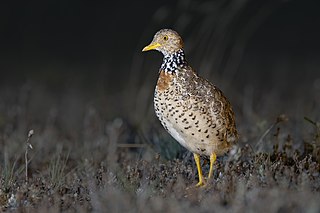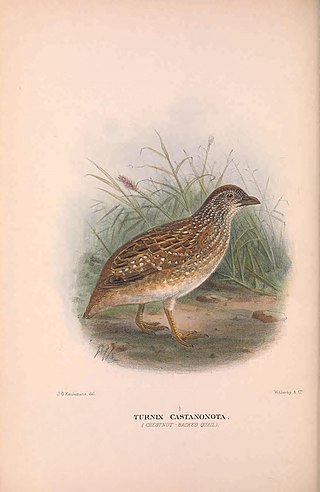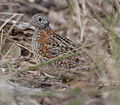
Charadriiformes is a diverse order of small to medium-large birds. It includes about 390 species and has members in all parts of the world. Most charadriiform birds live near water and eat invertebrates or other small animals; however, some are pelagic (seabirds), others frequent deserts, and a few are found in dense forest. Members of this group can also collectively be referred to as shorebirds.

The Gruiformes are an order containing a considerable number of living and extinct bird families, with a widespread geographical diversity. Gruiform means "crane-like".

Waders or shorebirds are birds of the order Charadriiformes commonly found wading along shorelines and mudflats in order to forage for food crawling or burrowing in the mud and sand, usually small arthropods such as aquatic insects or crustaceans. The term "wader" is used in Europe, while "shorebird" is used in North America, where "wader" may be used instead to refer to long-legged wading birds such as storks and herons.

The plains-wanderer is a bird, the only representative of family Pedionomidae and genus Pedionomus. It is endemic to Australia. The majority of the remaining population is found in the Riverina region of New South Wales.

The suborder Lari is the part of the order Charadriiformes that includes the gulls, terns, skuas and skimmers; the rest of the order is made up of the waders and snipes. The auks are now placed into the Lari too, following recent research. Sometimes, the buttonquails are also placed here, but the molecular data and fossil record rather suggests they are a quite basal offshoot along with the snipe-like and aberrant waders.

The barred buttonquail or common bustard-quail is a buttonquail, one of a small family of birds which resemble, but are closely related to, the true quails. This species is resident from India across tropical Asia to south China, Indonesia and the Philippines.

The common buttonquail, also called Kurrichane buttonquail, small buttonquail, or Andalusian hemipode is a buttonquail, one of a small family of birds which resemble but are not closely related to the true quails.

The painted buttonquail is a species of buttonquail, the family Turnicidae, which resemble, but are unrelated to, the quails of Phasianidae. This species is resident in Australia where numbers are believed to be in decline. A subspecies, the Abrolhos painted buttonquail, is endemic to the Houtman Abrolhos islands.

The king quail, also known as the blue-breasted quail, Asian blue quail, Chinese painted quail, or Chung-Chi, is a species of Old World quail in the family Phasianidae. This species is the smallest "true quail", ranging in the wild from southern China, South and Southeast Asia to Oceania, south to southeastern Australia, with 9 different subspecies. A failed attempt was made to introduce this species to New Zealand by the Otago Acclimatisation Society in the late 1890s. It is quite common in aviculture worldwide, where it is sometimes misleadingly known as the "button quail", which is the name of an only very distantly related family of birds, the buttonquails.

The little buttonquail is a species of buttonquail, part of a small family of birds which resemble, but are unrelated to, the true quails. This species is resident in Australia, where it is one of the more common buttonquails.

The stubble quail is a native Australian species which is the most common quail species in Australia. The species is not under any threat of extinction. Stubble quail are widespread and found throughout all states and territories of Australia excluding Tasmania. Other common names include grey quail and pectoral quail.

The black-breasted buttonquail is a rare buttonquail endemic to eastern Australia. As with other buttonquails, it is unrelated to the true quails. The black-breasted buttonquail is a plump quail-shaped bird 17–19 cm (6.7–7.5 in) in length with predominantly marbled black, rufous, and pale brown plumage, marked prominently with white spots and stripes, and white eyes. Like other buttonquails, the female is larger and more boldly coloured than the male, with a distinctive black head and neck sprinkled with fine white markings. The usual sex roles are reversed, as the female mates with multiple male partners and leaves them to incubate the eggs.

The quail-plover, lark buttonquail or lark-plover is a small ground-living bird in the buttonquail family Turnicidae that is found in the Sahel region of Africa and in a disjunct region of East Africa. It is the only species placed in the genus Ortyxelos.

The chestnut-backed buttonquail is a species of bird in the family Turnicidae. It is endemic to Australia.

The black-rumped buttonquail is a small species of bird in the buttonquail family.

The Madagascar buttonquail is a species of bird in the buttonquail family, Turnicidae, that is endemic to Madagascar and a few small islands nearby. It is a ground-dwelling species with an unusual breeding biology in which the sexual dimorphism is reversed, with female being more brightly coloured than the male and it is the male that incubates the eggs and mainly cares for the young.

The red-chested buttonquail is a species of bird in the family Turnicidae. It is endemic to Australia. The species is generally regarded as widespread, although uncommon, in New South Wales, Queensland, northern Western Australia and the Northern Territory, and classified as Vulnerable in Victoria.
Luzon buttonquail or the Worcester's buttonquail, is a species of bird in the family Turnicidae. It is endemic to the island of Luzon in the Philippines. Its natural habitat is subtropical or tropical high-altitude grassland. It is locally known as "Pugo". It is a cryptic species and not easy to observe and is listed as "Data Deficient" by the IUCN.

The pink robin is a small passerine bird native to southeastern Australia. Its natural habitats are cool temperate forests of far southeastern Australia. Like many brightly coloured robins of the family Petroicidae, it is sexually dimorphic. Measuring 13.5 cm (5.3 in) in length, the robin has a small, thin, black bill, and dark brown eyes and legs. The male has a distinctive white forehead spot and pink breast, with grey-black upperparts, wings and tail. The belly is white. The female has grey-brown plumage. The position of the pink robin and its Australian relatives on the passerine family tree is unclear; the Petroicidae are not closely related to either the European or American robins, but appear to be an early offshoot of the Passerida group of songbirds.

Old World quail is a collective name for several genera of mid-sized birds in the tribe Coturnicini of the pheasant family Phasianidae. Although all species commonly referred to as "Old World quail" are in the same tribe, they are paraphyletic with respect to the other members of the tribe, such as Alectoris, Tetraogallus, Ammoperdix, Margaroperdix, and Pternistis.



























